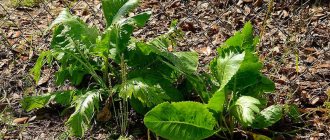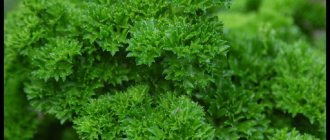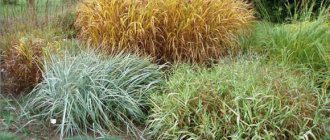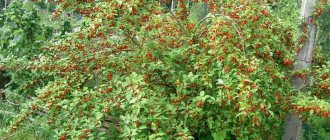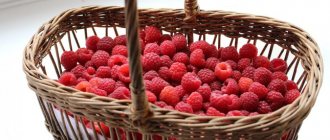Leafy vegetables
| White cabbage Brassica oleracea Family: Cruciferous (Cabbage) |
| Red cabbage Brassica oleracea Family: Cruciferous (Cabbage) |
| Kohlrabi Brassica oleracea var. gongylodes Family: Cruciferous (Cabbage) |
| Broccoli Brassica oleracea var. italica Family: Cruciferous (Cabbage) |
| Brussels sprouts Brassica oleracea var. gemmifera Family: Cruciferous (Cabbage) |
| Savoy cabbage Brassica oleracea convar. capitata var. sabauda Family: Cruciferous (Cabbage) |
| Chinese cabbage Brassica rapa subsp. pekinensis Family: Cruciferous (Cabbage) |
| Cauliflower Brassica oleracea L. var. botrytis L. Family: Cruciferous (Cabbage) |
| Chard Beta vulgaris Family: Amaranthaceae |
| Parsley Petroselinum Family: Umbrella |
| Dill Anethum Family: Umbrella |
| Basil Ocimum Family: Lamiaceae |
| Marjoram Origanum majorana Family: Lamiaceae |
| Savory Satureja Family: Lamiaceae |
| Mint Mentha Family: Lamiaceae |
| Melissa Melissa Family: Lamiaceae |
| Oregano Origanum Family: Lamiaceae |
| Tarragon Artemisia dracunculus Family: Asteraceae or Asteraceae |
| Sorrel Rumex Family: Buckwheat |
| Spinach Spinacia Family: Amaranthaceae |
| Fennel Foeniculum Family: Umbrella |
| Lovage Levisticum Family: Umbrella |
| Watercress Lepidium sativum Family: Cruciferous or Brassicas |
| Endive or Chicory salad Cichorium endivia Family: Asteraceae |
| lettuce Lactuca Family: Asteraceae |
What to plant first (in spring) in the garden
One of the first crops that you can sow in your garden is carrots. It is better to choose several varieties - early and intended for storage. It is recommended to sow more than normal in case germination is low. When the sprouts grow to 4-5 cm, they can be thinned out.
It is better to buy granulated seeds, since they are more reliable and easier to sow. Sowing is done in furrows spilled with water. Their depth should not exceed 2 cm. They should not be covered; simply sprinkle with mulch, soil, and sawdust. Watering should be done in a fine-drip manner, twice a day.
Fruit vegetables
Solanaceae
| Tomato or Tomato Solanum lycopersicum Family: Solanaceae |
| Vegetable pepper or Capsicum pepper Family: Solanaceae |
| Eggplant or Nightshade Solanum melongena Family: Solanaceae |
| Saraha edible or Saraha vegetable Jaltomata procumbens Family: Solanaceae |
Pumpkin
| Common cucumber Cucumis sativus Family: Cucurbitaceae |
| Zucchini Cucurbita pepo var. giromontina Family: Cucurbitaceae |
| Squash Patisson Family: Cucurbitaceae |
| Pumpkin Cucurbita Family: Cucurbitaceae |
| Chayote edible (Mexican cucumber) Sechium edule Family: Cucurbitaceae |
| Chinese bitter gourd or Bitter cucumber Momordica charantia Family: Cucurbitaceae |
| Lagenaria Lagenaria Family: Cucurbitaceae |
| Wax gourd Benincasa hispida Family: Cucurbitaceae |
| Cyclantera Cyclanthera Family: Cucurbitaceae |
| Luffa or Luffa Luffa Family: Cucurbitaceae |
| Trichosanth Trichosanthes Family: Cucurbitaceae |
| Antillean cucumber or Watermelon cucumber Cucumis anguria Family: Cucurbitaceae |
| Melotria rough Melothria scabra Family: Cucurbitaceae |
| Tladianta doubtful (Red cucumber) Thladiantha dubia Family: Cucurbitaceae |
Other
| Okra or Abelmosh edible Abelmoschus esculentus Family: Malvaceae (Malvaceae) |
Vegetable garden with poor drainage: possible plantings
On very wet soils, it is recommended to organize a drainage system, which can be of several types:
- vertical,
- stormwater,
- deep.
If it is not possible to do it, then you can think about what to plant in such a garden. During the entire growing season, not a single plant needs excess moisture. You can try planting crops in your garden that can withstand increased moisture. These include:
- zucchini,
- cucumbers
But it is best to plant such an area with flowers, for example:
- swimsuit (fries),
- primrose,
- forget-me-nots,
- swamp gladiolus.
Legume vegetables
| Peas Pisum Family: Legumes (Fabaceae) |
| Beans Phaseolus Family: Legumes (Fabaceae) |
| Vigna, green beans Vigna Family: Legumes |
| winged beans Psophocarpus tetragonolobus Family: Legumes |
Third bed - tomatoes
The third bed can be combined with the fourth and made into a team. Place seedlings and non-seedling tomatoes of all ripening periods on one, and eggplants and sweet peppers in a set of varieties on the second. Such a prefabricated bed can provide a family with fresh produce throughout the warm season, and make homemade canned preparations for the winter. For the south of the CIS and southern regions of Russia in table. Table 3 shows varieties and hybrids of tomatoes, low-growing and tall, the cultivation of which involves the installation of temporary trellises. Especially for central Russia, varieties have been given that form a commercial crop when cultivated in open ground.
Table 3: Varieties and hybrids of tomatoes for cultivation in summer cottages. Selection “NITSSA”, Research Institute of Agriculture, Transnistria)
| Name | From germination to first harvest, days | Plant height, cm | Fruit weight, g |
| Early tomatoes | |||
| Sanka | 79-85 | 40-60 | 80-100 |
| Aurora F1 | 79-85 | 80-90 | 110-120 |
| Golden heart | 80-85 | 30-40 | 80-100 |
| Pole 2 | 95-105 | 50-60 | 110-120 |
| Barberry F1 (Cherry) | 90-95 | up to 250 | 10-12 |
| Medium tomatoes | |||
| Ruslan | 105-110 | 200 | 250-350 |
| wild Rose | 110-115 | 180 | 300-400 |
| Ballad | 114-116 | 45-50 | 130-150 |
| Late tomatoes | |||
| Paradisaic delight | 122-128 | 250 | 400-500 |
| New from Transnistria | 120-125 | 60-70 | 40-60 |
Tomato varieties for central Russia
, early ripening varieties are recommended for cultivation in open ground : Nastenka, Totem, Ephemer, Explosion, Winter Cherry, Raspberry Surprise, Tsar-Bell. The varieties Black Iceberg, Vasilisa, Rococo, Baroque, Kuzya, Nolik, Tortila Lezhebok are distinguished by their high keeping quality (up to 3 months).
Breeders have specially bred tomato varieties not only for non-black soil regions, but also for northern conditions . They are resistant to low temperatures, have the ability to quickly regrow when damaged by spring frosts, do not require pinching or gartering, and provide a high yield of marketable fruits of good quality: Severyanin, Yamal, Taimyr, Bullfinch, Wind Rose.
Medium-ripening tomatoes are represented by large-fruited varieties: Pink Giant, King of Giants, Ox Ears (bunch-shaped inflorescence), De Barao, Buffalo Heart (fruits up to 1000 g), hybrid Tarasenko-6 (tassel 15-20 pieces) and a large list of other varieties and hybrids.
Late ripening tomatoes are not recommended for cold regions of Russia. They do not have time to ripen, even if they set fruit.
Tomatoes
Eggplant varieties and hybrids
In open ground, eggplants are grown mainly in the southern regions. In the middle non-chernozem zone, early dwarf varieties are recommended for cultivation in open ground: Dwarf early No. 921, Multifruit, Violet dwarf, Maikopsky 15. From the early ones, a good harvest is formed by Vikar, Vera, Black Beauty, Black Beauty.
For cultivation in open ground in the central non-black earth region and in the Moscow region, the following are recommended: Donskoy 014, Simferopolsky 12/105, Krymsky 714, Almaz.
Also recommended for open ground are early-ripening hybrid eggplants: Purple Miracle F1, Behemoth F1, Bagheera F1.
Sweet pepper varieties
For central Russia and the northwestern part, early varieties are recommended - Prince Silver, Orange King, Leader of the Redskins. Of the mid-season varieties, Bagira, Yatagan, Nastenka, Hercules, and Arsenal stand out for their taste and productivity. Ox ear.
Root and tuber vegetables
| Potato Solanum tuberosum Family: (Solanaceae) |
| Carrot Daucus Family: (Umbrella) |
| Beet Beta vulgaris Family: Amaranthaceae |
| Radish Raphanus Family: Brassicas (Brassicaceae) |
| Radish Radiculas Family: Brassicas (Brassicaceae) |
| Horseradish or Country Horseradish Armoracia rusticana Family: Brassicas (Brassicaceae) |
| Celery Apium Family: Umbrellas (Apiaceae) |
| Common parsnip or common parsnip Pastinaca sativa Family: Umbrellas (Apiaceae) |
| Sweet potato Ipomoea batatas Family: Convolvulaceae (Convolvulaceae) |
| Yam (vegetable group) Family: Dioscoreaceae |
| Edible cassava or Cassava Manihot esculenta Family: Euphorbiaceae (Euphorbiaceae) |
| Taro Colocasia edible or Dashin Colocasia esculenta Family: Araceae (Araceae) |
| Yacon Smallanthus sonchifolius Family: Asteraceae |
| Jerusalem artichoke or tuberous sunflower Helianthus tuberosus Family: Asteraceae |
| Turnip Brassica rapa Family: Cruciferae |
| Swede Brassica napobrassica Family: Cruciferae |
| Jicama or Pachyrisus notch Pachyrhizus erosus Family: Legumes (Fabaceae) |
| Chinese artichoke or Chistets related Stachys affinis Family: Lamiaceae |
| Scorzonera spanish or Kozelets Spanish Scorzonera hispanica Family: Asteraceae |
| Goatbeard or oat root Tragopogon porrifolius Family: Asteraceae |
| Burdock Arctium Family: Asteraceae or Compositae |
| Lotus Nelumbo Family: Lotus (Nelumbonaceae) |
| Oxalis tuberiferous or Oka Oxalis tuberosa Family: Oxalis |
| Nasturtium tuberous or Anyu Tropaeolum tuberosum Family: Nasturtium |
| Ulluco tuberiferous NULLucus tuberosus Family: Basellaceae |
| Arracacha edible Arracacia xanthorrhiza Family: Umbrella |
| Maca peruviana or Meyena Lepidium meyenii Family: Cruciferae |
Fourth bed - beets
Beets belong to the group of vegetables that are easy to care for, but necessary on the dinner table. A correctly selected (zoned) variety will provide half the success in obtaining a beet harvest with a long shelf life. According to the timing of harvest (from germination to harvesting), beets are divided into groups
- early ripening varieties - 80-100 days,
- mid-season – 100-130 days,
- late ripening – 130-145 days.
For areas with a warm climate and in the central zone of the Russian Federation, good early harvests are produced by Egyptian flat and Detroit, and the latter is characterized by keeping quality. Bordeaux and Bona can be recommended as mid-early varieties. Mulatto and Cold-resistant are famous for their excellent taste. Of the late varieties, the most common are One-Sprout and the very interesting late-ripening Dutch variety Tsilinra. Elongated root vegetables protruding 2/3 from the ground, juicy, sweet pulp, even dark red color, perfectly stored.
Bulb and stem vegetables
| Bulb onions Allium cepa Family: Alliums (Alliaceae) |
| Shallot, or Ashkelon onion Allium ascalonicum Family: Alliums (Alliaceae) |
| Leek, or Pearl bow Allium porrum Family: Alliums (Alliaceae) |
| Onion, or Fillet onion Allium fistulosum Family: Alliums (Alliaceae) |
| Slime Bow, or Onion drooping Allium nutans Family: Alliums (Alliaceae) |
| Sweet onion, or Branched onion Allium ramosum Family: Alliums (Alliaceae) |
| Garlic Allium sativum Family: Amaryllidaceae (Amaryllidaceae) |
| Asparagus Asparagus Family: Asparagus |
| Rhubarb Rheum Family: Buckwheat (Polygonaceae) |
| Sorrel Rumex Family: Buckwheat (Polygonaceae) |
First bed - green
We begin the fields of cultural circulation from left to right. On the first bed of our virtual crop rotation we will place greens (they can be in the 3rd...5-6th bed) - dill, parsley and lettuce. Such crops are called mixed. They are convenient if the family does not need a large amount of products. Greens are good predecessors for most crops and are patient with their neighbors. In the first field you can place any other crop and select a neighbor on the right for it, who will become its predecessor next year.
Dill, parsley, lettuce
It is best to use zoned varieties for garden crops. The varieties of dill, parsley and lettuce recommended below are distinguished by their bushiness and foliage, delicate persistent aroma, and quick yield. Cleaning is reusable.
Dill
- Early varieties of dill produce a harvest in 25-35 days - Aurora, Buket, Dalniy, Borey.
- Products of mid-season varieties can be harvested at 35-45 days - Fireworks, Buyan, Sultan, Mammoth.
Parsley
The named varieties form fragrant greens from early spring to late autumn - Ordinary, Curly, Sugar, Harvest.
Salads
Early ripening large-leaved varieties Bona and Dubachek form a harvest in 40-50 days, harvested when 6-10 leaves are formed. Of the zoned ones, the Moscow Greenhouse, Berlin, and Maikop are recommended for private gardening. The earliest variety of lettuce or Chinese cabbage is considered to be Khibinskaya POVIR. The variety has 5-6 developed leaves at 24-30 days from germination and must be harvested.
Lettuce bed
Rhubarb
Rhubarb stems have a delicate, sour taste. They are used to make jelly, compotes, jam, and pie filling. The color of the petioles can be red or green, depending on the variety.
The best varieties of rhubarb: Altai Zori, Beauty, Victoria, Zaryanka, Malachite, Stubborn, Candied.
Rhubarb reproduces well by seeds and grows in one place for about 10 years. But for proper development, the plant must be provided with fertile, loose and sufficiently moist soil.
The seeds are soaked in damp gauze and sown in the furrows after sprouts appear. When a pair of true leaves appear on the sprouts, the crops are thinned out so that the distance between the seedlings is at least 20 cm.
| Sowing depth | Sowing/planting scheme | The best predecessors | Good neighbors | Unwanted neighbors | Top dressing (per 1 sq.m.) |
| 2-3 cm | 20-25×30-35 cm | Lettuce, radishes, different types of onions | Perennial onions, horseradish, peas, cabbage, radishes, lettuce, celery, beans, spinach | Gooseberry | In spring and autumn, add 1 tbsp. ammonium nitrate and potassium sulfate and 2 tbsp. superphosphate |
Horseradish
Horseradish grows well without any care and can live in one place for up to 10 years, but to obtain more succulent roots, the plant needs to be provided with acidified and moist soil.
Horseradish is propagated by root cuttings with a diameter of 0.7-1.5 cm and a length of 20-25 cm. They are planted in spring or autumn, and buried obliquely at an angle of 45 degrees, so that there is a layer of earth 4-5 cm thick above the top point.
Horseradish varieties recommended for cultivation: Atlant, Valkovsky.
| Planting depth | Planting scheme | The best predecessors | Good neighbors | Unwanted neighbors | Top dressing (per 1 sq.m.) |
| 4 cm of soil above the spine | 30-40×60-70 cm | Potatoes, tomato, cucumber, beets, legumes | Potatoes, aromatic herbs | Strawberry, tomato, beans | In spring, add 1 tbsp. ammonium nitrate and potassium sulfate per 10 liters of water |

